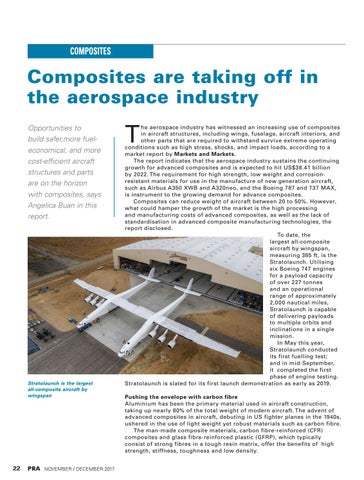Composites
Composites are taking off in the aerospace industry Opportunities to build safer,more fueleconomical, and more cost-efficient aircraft structures and parts are on the horizon with composites, says Angelica Buan in this report.
Stratolaunch is the largest all-composite aircraft by wingspan
22
NOVEMBER / DECEMBER 2017
T
he aerospace industry has witnessed an increasing use of composites in aircraft structures, including wings, fuselage, aircraft interiors, and other parts that are required to withstand survive extreme operating conditions such as high stress, shocks, and impact loads, according to a market report by Markets and Markets. The report indicates that the aerospace industry sustains the continuing growth for advanced composites and is expected to hit US$38.41 billion by 2022. The requirement for high strength, low weight and corrosionresistant materials for use in the manufacture of new generation aircraft, such as Airbus A350 XWB and A320neo, and the Boeing 787 and 737 MAX, is instrument to the growing demand for advance composites. Composites can reduce weight of aircraft between 20 to 50%. However, what could hamper the growth of the market is the high processing and manufacturing costs of advanced composites, as well as the lack of standardisation in advanced composite manufacturing technologies, the report disclosed. To date, the largest all-composite aircraft by wingspan, measuring 385 ft, is the Stratolaunch. Utilising six Boeing 747 engines for a payload capacity of over 227 tonnes and an operational range of approximately 2,000 nautical miles, Stratolaunch is capable of delivering payloads to multiple orbits and inclinations in a single mission. In May this year, Stratolaunch conducted its first fuelling test; and in mid-September, it completed the first phase of engine testing. Stratolaunch is slated for its first launch demonstration as early as 2019. Pushing the envelope with carbon fibre Aluminium has been the primary material used in aircraft construction, taking up nearly 80% of the total weight of modern aircraft. The advent of advanced composites in aircraft, debuting in US fighter planes in the 1940s, ushered in the use of light weight yet robust materials such as carbon fibre. The man-made composite materials, carbon fibre-reinforced (CFR) composites and glass fibre-reinforced plastic (GFRP), which typically consist of strong fibres in a tough resin matrix, offer the benefits of high strength, stiffness, toughness and low density.
